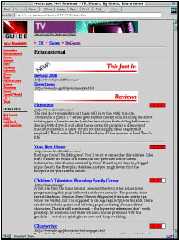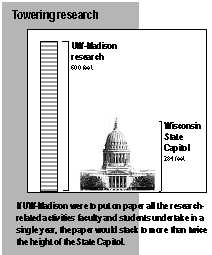- Mixed media
- The lines between broadcast, cable and the World Wide Web are blurring. That may signal the coming of the ultimate couch potato experience.

What's on the tube? Soon the Web will be, allowing your television to surf the Web's many guides to TV surfing.
For people who - like Orton and other UW research-ers - have developed research and teaching expertise on the Internet, predicting its future may be less exciting than jumping on-line right now. Orton teaches courses on Internet applications to business and academic groups and says present users are watching the technology reach critical mass. The band width is opening up and modems are moving faster, allowing quality video to be transmit-ted on the Web. Nearly every major corporation now sports a World Wide Web address to promote itself. Thousands of individuals have satiated their egos with Web pages promoting special interests. Access to education and health care has moved from institutions to living rooms. Orton says the Internet will certainly change the way we do business, from Web-based shopping to telecommuting. Employees no longer have to be attached to the office to be productive, when they can send documents by e-mail or assemble a work group from home. We will also see the emergence of a new form of digital currency, allowing us to make transac-tions and do our banking over the Internet. Orton says the banking industry is currently looking at no less than 10 digital-cash schemes that would allow secure bank transactions via electronic mail. Things happen at a breakneck pace on the Web, Orton says. The guiding principle seems to be that if people want it, it will happen. One example is using stationary video on Web pages, Orton says. That started a couple years ago with a popular lark called "The Amazing Fish Cam." A guy set up a video camera in front of his fish tank, and sent the image out on his Web page. It's gone from a joke to a useful service overnight, Orton says. Now, services in several metropolitan areas offer commuters video traffic reports on the Web, with live footage of the most congested sections of interstate. Perhaps the biggest lingering effect of the Internet, Orton says, is the empowerment it offers people to get involved. People can participate in government and politics in untold ways. A search for Web pages on presidential candidates, Orton says, will produce 10 "unofficial" pages supporting or attacking Bill Clinton and Bob Dole, right next to the freshly scrubbed "official" documents. "The fact that there's anarchy out there - and you can put out practically anything you want - allows people to be part of things," Orton says. "There's word of mouth on the Net, and 30,000 people a day will find you if you have something interesting to say. It's a blossoming of personal expression, the likes of which we've never seen before."
- Q&A
- A by-the-numbers look at the factors that make UW-Madison's research enterprise run smoothly.
At any one time, 9,500 research projects are underway at UW-Madison, involving members of the faculty and academic staff, as well as graduate and undergraduate students. While many faculty members receive grants to conduct research, countless others carry on research projects without the aid of grant money.
How much money does UW-Madison receive from external sources for research?
In 1994-95, UW-Madison received $471 million in extramural support - which includes grants from federal and nonfederal sources for all university functions. Of that support, $372.6 million was awarded explicitly for research.
How much money does UW-Madison spend on research?
In 1994-95, UW-Madison spent $369.5 million on research projects. It ranks third nationally among all universities in terms of research expenditures.
How is money from a grant spent?
How grant money is used is specified in each grant, but in general most goes to hire and pay a research team and fund the supplies necessary for the project. A portion of most grants is devoted to research overhead, which includes costs such as utilities and building maintenance and depreciation that the university incurs with research.

How much research funding comes from the federal government?
Nearly $300 million in awards for research came from federal sources in 1994-95. Grants from four federal agencies - Health & Human Services, the National Science Foundation and the departments of Defense and Energy - comprised more than 75 percent of that sum. Health & Human Services accounted for the largest portion, awarding 621 grants worth more than $141 million. (see graph, next page)
What role does the state play in funding research?
Revenue from the state of Wisconsin plays a vital role in funding all programs at UW-Madison, including research. In the 1997-98 budget, 10 percent of UW-Madison's research allocations come from state general program revenue, totaling $47 million. During the past two decades, the state's share of general program revenue funding has declined. Of the state's research allocations for 1997-98, 46 percent are targeted for the College of Agricultural & Life Sciences.
How competitive is the funding environment?
Competition for grant money is quite fierce. Although UW-Madison is generally very successful in winning grants, nationally only one of every 10 grant applications wins funding.

